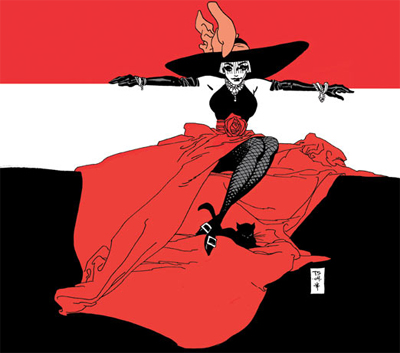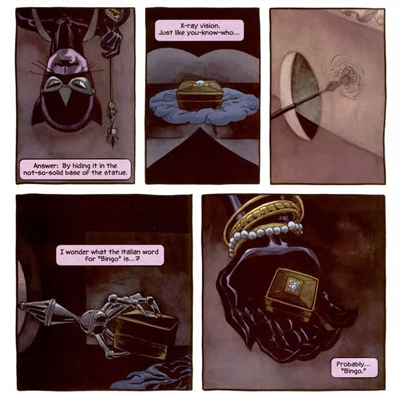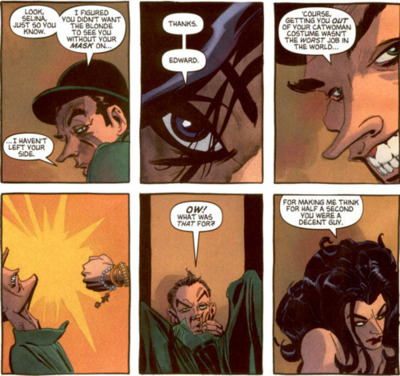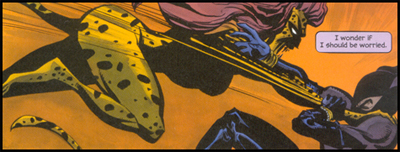To celebrate the release of The Dark Knight Rises, July is “Batman month” here at the m0vie blog. Check back daily for comics, movies and television reviews and discussion of the Caped Crusader.
Catwoman: When in Rome technically exists to fill in the gaps in Jeph Loeb and Tim Sale’s The Long Halloween and Dark Victory, particularly in accounting for Catwoman’s absence during the early part of Dark Victory. However, it also exists as something of a “bridge”, connecting Loeb’s earlier Batman trilogy with Sale and his later work on Hush with Jim Lee. It’s an interesting exploration of an early phase of Catwoman’s costumed career, building off her origin in Batman: Year One and seeing the character attempt to move out of Batman’s shadow. While it’s hardly going to be remembered for developing a truly independent version of the character, it does make for an interesting read, and a fascinating companion piece to the rest of Jeph Loeb’s Batman work.
During Catwoman: When in Rome, Selina Kyle is pretty much defined by her relationship to Batman. The miniseries sees the famous cat burglar visiting Italy in an attempt to trace her roots, but she’s forever haunted by her association with the Bat. Her traveling companion is none other than Edward Nigma (aka the Riddler) and her Italian companion is very clearly a substitute for Bruce. While Selina is hoping to find her own history, she’s immediately surrounded by Batman’s iconic paraphernalia.
A local mob boss is assassinated using the Joker’s toxin, Selina is undermined using the Scarecrow’s fear gas, the traveling troupe are attacked using Mr. Freeze’s ice gun. The only key DCU character here not directly linked to the Batman mythos is the mercenary Cheetah, who seems so perfect a choice to take on Catwoman that it’s hard to believe the pair don’t have a longer and deeper association. However, for the most part, Selina here is defined (and, to an extent, confined) by her relationship to Batman.
There is a relatively small supporting cast developed here. The most important figure is clearly a stand-in for Bruce Wayne in Selina Kyle’s affections. He lost his parents at a young age, should be against her and yet can’t seem to resist her – yet the pair remain in a suspicious yet respectful relationship. The rest of the cast is generic at best, with the nun Selina suspects of being her mother as the only other vaguely important character. This isn’t the expansive and distinct supporting cast that Ed Brubaker and Darwyn Cooke would develop in their own Catwoman book.
However, that isn’t too big a problem. Catwoman is, after all, a supporting character in the Batman mythos – much like Robin, Alfred, Commissioner Gordon or even the Joker. Loeb here isn’t trying to tell a unique and isolated Catwoman story – he’s telling a story about Catwoman in the context of a larger Batman narrative. It might feel a tad disappointing for those looking for a great Catwoman story, but When in Rome is effectively a subplot in a larger and more expansive story, one that happens to be focused more around Batman than about Catwoman.
That doesn’t mean that Selina herself is undeveloped. This is, after all, about her journey to confirm her parentage. However, a large amount of her development is relative to Bruce – feeling like an attempt to bridge The Long Halloween and Hush, Catwoman: When in Rome explores the Batman-Catwoman dynamic from her perspective, rather than his. We see that not only is Bruce an object of her desire, he’s also a source of her deeply-rooted fears.
In her dreams, he’s always there. There’s no escaping him. “I’m here,” Bruce states. “I’m always here to protect you.” It seems that Catwoman fears being caught in as nothing but a side-character in Batman’s story. Catwoman responds to him, “What are you doing? We’ve been over this? I’m not some dumb damsel in distress you get to play Dark Knight with. We’ve got issues. Trust issues.” In a way, When in Rome feels like an attempt by the character to strike out and find her own identity, despite being trapped by her association with Batman.
It’s telling that although the villain of the story is on really interested in Selina as far as she relates to Batman (“you drugged me because you thought I knew Batman’s secret identity”), Selina manages to solve her own problems without the assistance of Batman (or even her substitute for Bruce). Batman appears repeatedly in the story, but only as a figment of Selina’s unconscious – a memory or a nightmare. Confronting the Riddler, she observes, “The Riddler got into my head and plucked out the very thing I feared the most. A world in which everywhere I turned, Batman was there to save me.”
You could read When in Rome as an attempt by Catwoman to establish her own identity and to break out of the shadow she’s inhabited since Batman #1 all those years ago. There’s an interesting case be made that this represents Selina’s first true solo adventure – operating outside of Gotham an in a completely different control. In defeating the Riddler and his gang, she ends the story by proving that shecan exist without relying on Batman and his supporting cast – perhaps leaving her open to develop her own. It’s hardly the strongest possible reading, but it’s the one that recognises Catwoman as more than just a supporting player to Batman.
Of course, When in Rome is arguably more significant for the role it plays in Loeb’s grand Batman adventure. Obviously it exists in parallel with Dark Victory and helps close the book on that sort of early phase of Batman’s career. Dark Victory ends with Bruce taking on Dick Grayson as Robin, and When in Rome demonstrates that super-crime has well and truly gone international. When the mob in Italy is introduced to Joker toxin and freeze guns, it represents a sign that things have truly changed – a change that Batman began in Gotham during Year One and his adversaries continued in The Long Halloween.
It’s fitting that this adventure ends with Selina saying a final farewell to her father, the Roman. “So this is goodbye,” she states. “We never spoke while you were alive, so I don’t see much reason in starting now.” His time is well and truly over, to the point where even his own daughter has decided to move on. Selina is no longer defined by any of her possible pasts, but by what lies ahead of her. The miniseries ends by closing out that unfortunate “prostitution” thread that Frank Miller introduced in Year One and restoring Selina’s classic persona and identity – the skilled thief who conned her way into high society.
Jeph Loeb clearly patterned The Long Halloween after The Godfather, right down to the opening wedding scene and numerous other references scattered throughout the text. If that’s the case, then Selina’s trip to Rome feels like a combination Michael’s Italian side-plot from the first film, combined with the flashbacks from the second – an excuse to dig into the rich mob history and offer a bit of depth to the action unfolding in the present half the world away. We learn more about the Falcone family history here than we do throughout The Long Halloween or Dark Victory.
It’s all filtered through Loeb’s noir sensibilities. I don’t think that Loeb is the finest writer ever to work in comic books, and I’ll concede that his more recent work has been abysmal. However, I hold a soft spot for his Batman work, if only because his partnership with Sale is very strong, and because the atmosphere compliments his gritty and cynical tone. “It’s the story of my life,” Selina observes towards the end of the story. “It’s never about who wins. It’s about who loses the least.” As much as a superhero story can be noir, I think that The Long Halloween, Dark Victory and When in Rome all play into it perfectly.
However, while When in Rome is very much structured as a part of The Long Halloween and Dark Victory, it also serves as something akin to connective tissue, linking Loeb and Sale’s work to Loeb’s collaboration with Jim Lee on Hush. You can see several of the ideas retroactively introduced her, making for a strong thematic bridge. There is, of course, the relationship between Batman and Catwoman, foreshadowed heavily (perhaps too heavily) here. “Let’s go,” Selina’s dream Batman insists. “Right now. Take off the masks. No secrets.” The pair would agree on this during Hush, and Loeb even hints here that Selina is subconsciously aware that Bruce Wayne is Batman – tripping over their names during a dream. “Huh,” she muses. “Funny that I’d think Bruce when I meant Batman.”
Like Hush, When in Rome seems to focus on Loeb’s version of the Riddler. You could make a very serious case that the Riddler is actually the primary antagonist of Hush, masterminding a psychological war against the Caped Crusader after discovering his secret identity. There’s a lot of overlap between how Loeb presents Edward Nigma in the two stories. In both, Nigma is initially presented as something of a foul, a scrawny easily-defeated villain who probably couldn’t hold his own against any of Batman’s iconic villains. Here he’s so petite he can comfortably fit into Catwoman’s outfit.
Nigma is treated like a joke for most of the story, much like his early defeat in Hush. At one point, he’s little more than a petulant child. “Lemme see,” he moans while Blondie watched the action through binoculars. “Lemme see.” He’s presented as little more than a sleaze at other points in the story. Revealing he remained by Catwoman’s bedside, he observes, “‘Course, getting you out of your Catwoman costume wasn’t the worst job in the world…” Treated as comic relief, the character is frequently bunted out of rooms in the most cartoonish manner possible.
However, Loeb suggests there’s a more sinister personality bubbling just below the surface. He’s obsessed with solving the greatest riddle of all ‘Who is Batman under the mask?’, and is willing to go to great lengths to solve it. “Maybe, someday, he’ll solve that riddle of “Who is Batman under the mask?” for all the good it’ll do him,” Selina observes, and that’s exactly what happens in Hush. Of course, the tragedy of Hush is that he can’t actually do anything with that knowledge.
Loeb present Nigma as an inherently parasitic villain. He needs Cheetah, the Scarecrow and Mr. Freeze’s weapon to help in his scheme here, and Hush demonstrates he’s unable of confronting the Dark Knight directly. Even the ending of the story seems to tie into Jeph Loeb’s work on Hush, as Nigma tucks his tail between his legs – terrified the Joker will kill him for stealing the Joker toxin. In Hush, Nigma is shown to be just as terrified of the tougher villains in Batman’s rogues’ gallery, afraid of Ra’s Al Ghul learning he used the Lazarus Pit.
So it’s an entertaining and well-constructed story. Although I will concede that perhaps Loeb leans a little bit too heavily on the word “bitch.” I understand that there’s a bit of irony in referring to Catwoman as a female dog, but it seems like Loeb throws the word around with far too much comfort, an attempt to give the story a bit of an edge. Characters in his stories don’t tend to refer to Batman as “bastard” (very arguably the male equivalent) quite as much. It doesn’t ruin the story, but it seems that Loeb falls back on it too often. Don’t get me wrong, I don’t mind fiction that uses the word in a realistic context – to give a story a more naturalistic flavour, because people do swear and sometimes bad people are misogynists. However, given how bowlderised the rest of the text seems to be both here and in Loeb’s other work, it can’t help but feel a bit weird.
Sale’s artwork is as beautiful as ever. His watercolours are absolutely stunning, and it’s a joy to see his classical style brought to Batman again. It perfectly compliments Loeb’s noir aesthetic, and I genuinely believe that Tim Sale is one of the iconic Batman artist – certainly one of best and most defining artists to work on the character within the last twenty years or so. Catwoman: When in Rome never fails to look absolutely lovely.
Catwoman: When in Rome might not be the best stand-alone Catwoman story ever told. I’m still disappointed that DC didn’t solicit a nice hardcover of the Darwyn Cooke and Ed Brubaker series to tie into The Dark Knight Rises. However, it is a fitting tie-in to Jeph Loeb and Tim Sale’s Batman work, while also seeming to retroactively set up many of the threads Loeb would bring into play for Hush. I’m not sure that it stands especially well apart from that supporting frame work, but it is highly enjoyable when read within it.
Filed under: Comics | Tagged: batman, Bruce, catwoman, Catwoman: When in Rome, Christopher Nolan, Dark Knight Rises, godfather, jeph loeb, joker, riddler, rome, Selina |






























Leave a comment